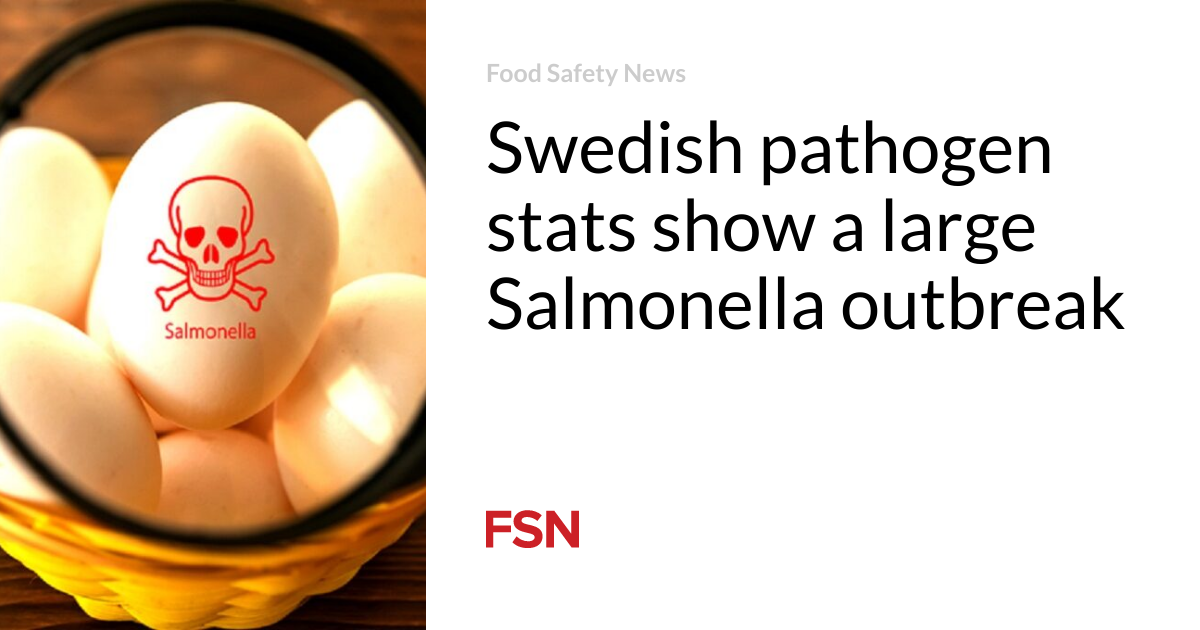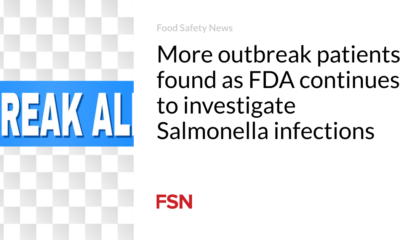Food
Swedish pathogen statistics show a major outbreak of Salmonella

Sweden has released data on human infections for 2023, including a major Salmonella outbreak that had major economic consequences and caused egg shortages.
The data comes from a report published by the State Veterinary Institute (SVA) with assistance from the Swedish Public Health Agency (Folkhälsomyndigheten) and the Swedish Food Organization (Livsmedelsverket).
A total of 1,316 Salmonella infections were reported, compared to 1,137 in 2022. More than half became infected abroad. Thailand was the country with the most infections, followed by Turkey, Greece and Spain. Domestic cases fell slightly.
The incidence was highest in children under five years of age. For household cases, the most common species were Salmonella Enteritidis, Typhimurium and monophasic Salmonella Typhimurium. An additional 68 different serovars were identified.
Three outbreaks with ten or more cases were found. The most notable incident sickened 82 people and was traced to eggs produced at CA Cedergren, Sweden’s largest laying hen facility. A closely related strain of Salmonella Enteritidis caused a major outbreak in Belgium in 2022, with hundreds of sick people, which was also linked to a laying hen house in that country.
At the end of December 2022, Salmonella Enteritidis was found in two flocks in Sweden and the eggs of these birds were recalled. Positive flocks were euthanized, infected sites were cleaned, and biosecurity among the remaining flocks was improved. Salmonella was found in a further 14 flocks on the farm between February and October. At the end of 2023, all chickens present were killed and a new round of extensive cleaning and disinfection was carried out.
Another outbreak of Salmonella Enteritidis involved chicken. Austria has found the outbreak strain in chicken kebabs produced in Poland. However, these products were not served in restaurants where sick Swedish cases had eaten. Instead, return to work on chicken products, which identified Thailand as the country of origin.
The outbreak involved 13 Swedish cases and 42 from other European countries. The outbreak strain was similar to a major outbreak in the EU linked to breaded chicken. Swedish officials said it is likely that this species is circulating in chicken populations in Europe and Asia.
E. coli and Listeria
939 cases of E. coli were reported, of which 608 were domestically contaminated. As in previous years, the incidence was highest in children under 5 years of age.
A total of twenty cases of STEC-associated hemolytic uremic syndrome (HUS) were reported, of which 14 were infected in Sweden. Nine HUS cases involved children younger than 10 years. Of the 492 isolates typed, 92 different serotypes were identified. The most common were O157:H7, O26:H11 and O103:H2.
Two people who ate cream cheese made from unpasteurized milk became ill in July. Isolates from human cases could not be typed, but STEC O26 was found in a sample of cheese from the same shed. Two international outbreaks have been investigated. One of these was due to STEC O146:H28, with 15 cases in Sweden and also cases in Belgium and Denmark. The second was caused by STEC O157:H7, where Sweden had 11 cases and infections occurred in the Netherlands and Great Britain. No source could be confirmed in these outbreaks.
Listeriosis was at similar levels to 2022, with 131 cases in 2023 compared to 125 cases the year before.
The majority of cases belonged to the older age groups. In 2023, the average age was 77 years and most sick people were over 80 years old. Forty-one people died within a month of diagnosis.
Analysis showed that 52 percent of the isolates belonged to a cluster. A total of 23 different clusters were found, 19 of which contained identical or closely related isolates identified before 2023.
From May to August, 15 people became ill during a Listeria outbreak. The samples from patients were similar to those from four sick people during an outbreak linked to cold-smoked salmon in 2022. In August, the outbreak strain was found in product samples from the same company in Sweden that was part of the 2022 outbreak and in samples from the location and equipment of the facility.
The producer receives salmon raw material from two slaughterhouses in Norway, and one of these sent isolates from the sampling to the Swedish Food Agency. The results showed that the isolates clustered with isolates from human cases, food and environmental samples from the outbreak, indicating that the outbreak strain entered the production facility in Sweden with raw salmon material that had been contaminated during processing in Norway.
Other highlighted data
A total of 5,676 Campylobacter infections were reported. Travel-related cases increased compared to 2022, while domestic infections remained stable.
For domestic cases, the average age was 50 years, with a range from several months to 99 years. The incidence was highest in the age group 50 to 69 years.
Swedish experts say a correlation between human infections and Campylobacter-positive broiler flocks underlines the need for continued preventive measures.
In 2023, 328 cases of yersiniosis occurred, the majority of which were infected in Sweden. The incidence was highest among children under five years of age. An outbreak in May also included a school in Stockholm. Iceberg lettuce from Spain was the suspected source of contamination.
A total of 741 cases of cryptosporidiosis were recorded. The average age was 35 years and 59 percent were women. Due to several outbreaks, most domestically infected cases were reported in September, October and December.
In September, 126 cases were reported from 12 regions, almost half of them from Stockholm. The study found a link with domestically grown kale distributed to several restaurant kitchens. A small outbreak in four patients was linked to unpasteurized goat cheese.
Ten cases of brucellosis were reported, all of which were infected abroad. For six people, unpasteurized dairy products were the likely source of infection.
(To sign up for a free subscription to Food Safety News, click here.)













